
In this video, Sal walks through a practice exercise calculating the CPI and inflation.
- Subject:
- Economics
- Social Science
- Material Type:
- Lesson
- Provider:
- Khan Academy
- Provider Set:
- Khan Academy
- Author:
- Sal Khan
- Date Added:
- 07/27/2021

In this video, Sal walks through a practice exercise calculating the CPI and inflation.
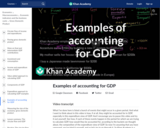
Thinking about how different types of expenditures would be accounted for in GDP. Created by Sal Khan.

Learn about what an exchange rate is and how to determine the cost of goods in another currency.

In this video, we explore how purchases of different things affect GDP, or why they wouldn't!

Price changes the quantity supplied, but what might cause supply to increase even if price hasn't changed? In this video, we explore the determinants of supply: those factors that cause an entire supply curve to shift. Created by Sal Khan.

The Fair model web site includes a freely available United States macroeconomic econometric model and a multicounty econometric model. The models run on the Windows OS. Instructors can use the models to teach forecasting, run policy experiments, and evaluate historical episodes of macroeconomic behavior. The web site includes extensive documentation for both models. The simulation is for upper-division economics courses in macroeconomics or econometrics. The principle developer is Ray Fair at Yale University.

How a currency crisis in Thailand led to a banking crisis in the 1990s. Created by Sal Khan.
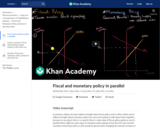
In previous lessons we've learned how expansionary monetary policy and expansionary fiscal policy can be used to mitigate a recession, but they don't have to be used in isolation from each other. Often there is simultaneous use of fiscal and monetary policy. Learn what happens when they are used at the same time in this video.
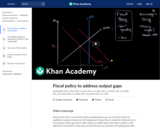
Fiscal policy can be used to close output gaps. Fiscal policy means using either taxes or government spending to stabilize the economy. Expansionary fiscal policy can close recessionary gaps (using either decreased taxes or increased spending) and contractionary fiscal policy can close inflationary gaps (using either increased taxes or decreased spending).

Economists traditionally divide the factors of production into four categories: land, labor, capital, and entrepreneurship. Land refers to natural resources, labor refers to work effort, and capital is anything made that is used to make something else. The last resource, entrepreneurship, refers to the ability to put the other three resources together to create value. In this video, we define each of the four factors of production and provide examples of each.

According to Prof. Don Boudreaux of George Mason University, free trade is nothing more than a system of trade that treats foreign goods and services no differently than domestic goods and services. In this video, Professor Boudreaux defines free trade and protectionism and provides real world examples of free trade.

Overview of full reserve banking in comparison to fractional reserve banking. Created by Sal Khan.

What does money actually do? Economists usually subdivide its functions into three categories: A medium of exchange, a store of value, and a unit of value. Created by Grant Sanderson.
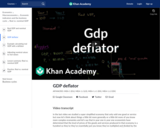
The GDP deflator is a way of adjusting nominal output to get the real value of output. In this video, get an intuitive explanation of the GDP deflator and learn how to calculate the GDP deflator. Created by Sal Khan.

Generalizing a linear consumption function as a function of aggregate income. Created by Sal Khan.

Gilded Age versus Silicon Valley. A discussion with Sal Khan.
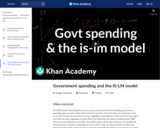
How a change in fiscal policy shifts the IS curve. Created by Sal Khan.
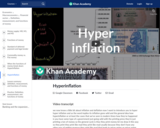
Basic of hyperinflation. Weimar Germany, Hungarian Pengo and Zimbabwean Dollar. Created by Sal Khan.

Income inequality in America is a serious issue. People are worried about a widening gap between the rich and the poor in the United States. But is the global story the same? In this video, Professor Tyler Cowen of George Mason University explains how globalization is affecting income inequality worldwide.

In this video we explore an alternative method of calculating GDP: the income approach. The intuition behind the income approach is pretty straightforward because every time you spend money, that spending is someone else's income. Learn more about the income approach and its categories: wages, interest, rent, and profit. Created by Sal Khan.